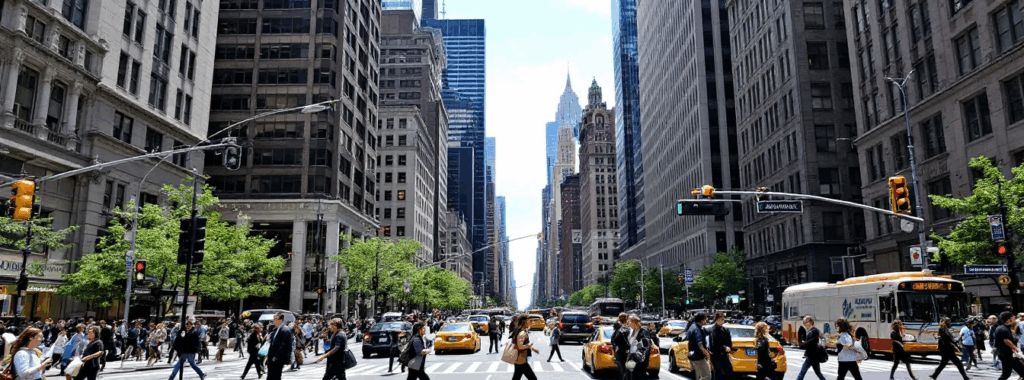
Pedestrian Hit by Car Manhattan: Complete Guide to Accidents, Rights, and Legal Options
Being a pedestrian hit by a car in Manhattan is unfortunately common, with over 2,600 injuries requiring emergency room visits annually, according to recent city data. The dense traffic, countless intersections, and constant flow of tourists and residents create a perfect storm for pedestrian accidents across Midtown Manhattan, Fifth Avenue, and other high-traffic areas.
This guide covers what to do immediately after an accident, your legal rights under New York law, and how to protect yourself in one of America’s most challenging cities for pedestrian safety.
Understanding Pedestrian Accidents in Manhattan: Key Facts and Legal Definitions
A pedestrian accident occurs when a person walking, standing, or crossing the street is struck by a vehicle, including cars, box trucks, minivans, or other motor vehicles. In Manhattan, these incidents range from minor injuries to fatal crashes, with the severity often depending on vehicle speed, intersection design, and the circumstances of the accident.
A hit-and-run accident refers to an incident where a driver flees the scene after striking a pedestrian, failing to stop and provide assistance as required by New York law. This is a serious criminal offense that can result in felony charges, especially if the victim suffered serious injury or was killed.
Comparative negligence is New York’s legal standard that allows pedestrians to recover compensation even if they partially contributed to the accident. For example, if a pedestrian is jaywalking but the driver is speeding, both parties may share fault; however, the victim can still receive damages.
Key terms you’ll encounter include:
- Right-of-way violations: When drivers fail to yield to pedestrians in crosswalks
- Failure to yield: The most common cause of pedestrian accidents at intersections
- Vehicular assault: When a driver intentionally strikes a pedestrian or acts with extreme recklessness
How Manhattan Pedestrian Accidents Connect to Broader Safety Issues
Manhattan pedestrian accidents are directly linked to the city’s Vision Zero initiative, launched in 2014 to eliminate traffic deaths. Despite improvements in intersection design and traffic enforcement, the sheer volume of pedestrians and vehicles continues to create dangerous conditions.
The connection between accident frequency and factors includes:
- Infrastructure design: Poorly designed intersections lacking proper crosswalk visibility
- Traffic enforcement: Inconsistent police presence at high-accident locations
- Driver behavior: Distracted driving, failing to yield, and excessive speed
- Insurance and liability: Complex cases involving city responsibility, driver fault, and compensation claims
Why Pedestrian Safety is Critical in Midtown Manhattan
Recent statistics paint a sobering picture of pedestrian safety in Manhattan. In the first six months of 2025, New York City recorded 51 pedestrian fatalities citywide, down from 63 the previous year – a 19% improvement. However, Manhattan specifically saw approximately 2,600 pedestrian injuries in 2024, representing a 16% increase from 2022 levels.
The economic impact of these accidents exceeds $2 billion annually for New York City when factoring in medical costs, lost wages, legal proceedings, and long-term care needs. Individual cases often result in settlements ranging from $50,000 for minor injuries to over $1 million for severe or fatal accidents.
Manhattan stands apart from other boroughs due to its unique risk profile:
- High injury but lower fatality rate compared to Brooklyn or Queens
- Dense traffic patterns that reduce vehicle speed but increase conflict points
- Tourist vulnerability: Visitors unfamiliar with traffic patterns face elevated risk
- Complex intersections: Areas like Times Square, Union Square, and Columbus Circle see disproportionate accident rates
Recent high-profile cases highlight ongoing dangers. The 2024 fatal accident involving German tourists at 40th Street and Fifth Avenue, where driver Mohamed Abouzaid was charged with leaving the scene, demonstrates how quickly a routine crossing can turn tragic.
Manhattan Pedestrian Accident Statistics and Dangerous Location Comparison
| Location | Annual Accidents | Fatality Rate | Primary Risk Factors |
|---|---|---|---|
| Times Square/42nd Street | 89 incidents | 2 deaths | Tourist confusion, heavy traffic |
| Union Square (14th St) | 67 incidents | 1 death | Complex intersection, multiple lanes |
| Columbus Circle (59th St) | 54 incidents | 3 deaths | High-speed traffic, poor visibility |
| Fifth Avenue/34th Street | 78 incidents | 2 deaths | Delivery vehicles, pedestrian volume |
| Houston Street Corridor | 91 incidents | 4 deaths | Speed, limited crosswalks |
Seasonal and Time-Based Patterns:
- Peak accident times: 3-7 PM weekdays during rush hour
- Highest risk months: November-January due to reduced daylight and weather
- Weekend vs. weekday: Tourist-heavy areas see more weekend incidents
- Demographics most at risk: Adults over 65, children under 12, and international tourists
The data shows that 67% of serious pedestrian crashes occur at intersections, with another 25% happening at mid-block crossings. Critically, 92% of pedestrian deaths occur at intersections lacking proper “daylighting” – design features that improve visibility between drivers and pedestrians.
What to Do When Hit by a Car in Manhattan
Step 1: Immediate Response and Safety
Call 911 immediately – Request both police and ambulance response to the scene, even for seemingly minor injuries. Manhattan’s busy streets require official documentation, and injuries may not be immediately apparent due to effects of shock and adrenaline.
Move to safety if possible – If you can move without risk of further injury, get to the sidewalk or a safe area away from traffic. If you cannot move, signal for help and remain still until emergency responders arrive.
Document the scene thoroughly:
- Take photos of vehicle damage, your injuries, and the accident location
- Capture traffic signals, crosswalk markings, and any relevant street signs
- Note the time, weather conditions, and lighting
- Record the license plate of any vehicle involved
Gather driver information:
- Driver’s license and insurance details
- Vehicle make, model, and registration
- Contact information for the driver
- Note if the driver shows signs of impairment or distraction
Step 2: Legal Documentation and Evidence Gathering
Obtain the official police report – Get the responding officers’ names and badge numbers, along with the incident report number. This document will be crucial for any insurance claim or legal proceeding.
Collect witness information:
- Names and contact details of anyone who saw the accident
- Ask witnesses to provide brief written statements if possible
- Note the location where witnesses were standing during the incident
Preserve physical evidence:
- Keep damaged clothing, bags, or personal items
- Don’t repair or replace damaged property immediately
- Take additional photos from multiple angles
- Document any skid marks, debris, or other physical evidence
Avoid common documentation mistakes:
- Never admit fault or apologize at the scene
- Don’t discuss details with the driver’s insurance company without representation
- Refuse any immediate cash settlement offers
Step 3: Medical Care and Legal Protection
Seek immediate medical evaluation – Many serious injuries, including traumatic brain injury and internal bleeding, may not show symptoms immediately. Emergency room documentation creates an official medical record linking your injuries to the accident.
Follow up with specialists – See appropriate specialists for any ongoing symptoms, pain, or mobility issues. Maintain detailed records of:
- All medical appointments and treatments
- Prescription medications and medical devices
- Physical therapy or rehabilitation services
- Lost work time and wages
Contact a Manhattan pedestrian accident attorney within 48 hours– New York’s complex insurance laws and the potential for city liability make legal representation essential. An experienced attorney can:
- Handle communications with insurance companies
- Preserve crucial evidence before it’s lost
- Ensure you meet all legal deadlines
- Maximize your compensation recovery
Protect your legal rights:
- Report the accident to your insurance company but avoid detailed recorded statements
- Don’t sign any documents without attorney review
- Keep a detailed diary of your injuries and recovery process
Common Mistakes Pedestrians Make After Manhattan Accidents
Leaving the scene without proper documentation: Many pedestrians, especially tourists, accept cash payments from drivers or leave without involving the police. This makes it nearly impossible to seek additional compensation later when medical bills mount or injuries worsen.
Admitting fault or apologizing at the scene: Statements like “I’m sorry” or “I should have been more careful” can be used against you later. New York’s comparative negligence law means even partial fault can reduce your compensation.
Delaying medical treatment: Waiting days or weeks to see a doctor gives insurance companies ammunition to argue your injuries weren’t serious or weren’t caused by the accident. Seek medical attention immediately, even if you feel “fine.”
Talking to insurance adjusters without representation: The driver’s insurance company will often contact victims quickly with low settlement offers. These initial offers rarely reflect the true cost of your injuries, especially if you develop complications or need ongoing treatment.
Pro Tip: Document everything immediately and never accept the first settlement offer. Insurance companies count on victims not understanding the full scope of their injuries or their legal rights. Having an attorney review any offers ensures you receive fair compensation for both current and future medical expenses, lost wages, and pain and suffering.
Real-Life Case Study: German Tourist Hit-and-Run at Fifth Avenue
Case Overview: In 2024, a tragic pedestrian accident on Fifth Avenue near 40th Street killed a German tourist and seriously injured her husband, highlighting the deadly consequences of driver negligence in Manhattan.
Incident Details: The couple was crossing Fifth Avenue in a marked crosswalk when they were struck by a minivan driven by Mohamed Abouzaid. Instead of stopping to render aid as required by law, Abouzaid fled the scene, leaving the woman dying in the street and her husband critically injured.
Investigation and Charges:
- NYPD officers quickly identified the vehicle through witness descriptions and traffic cameras
- Abouzaid was taken into custody and charged with leaving the scene of a fatal accident (a hit and run)
- Additional charges included failure to yield to pedestrians and reckless endangerment
- The investigation revealed the driver was speeding and failed to slow down at the intersection
Legal Outcome:
- The case highlighted the importance of immediate police response and witness testimony
- Traffic cameras provided crucial evidence that led to the driver’s arrest
- The family’s legal team was able to pursue both criminal prosecution and civil compensation
- The incident prompted renewed calls for enhanced intersection safety measures
Lessons Learned:
- Even fatal hit-and-run cases can be solved through proper evidence collection
- Witness testimony proved crucial in identifying the fleeing vehicle
- The importance of traffic cameras in Manhattan accident investigations
- How quickly a routine crossing can turn fatal without proper driver attention
Safety Improvements: Following this tragedy, the city implemented enhanced traffic safety measures at the intersection, including improved crosswalk visibility and additional traffic enforcement during peak pedestrian hours.
Contact the Law Office of Nicholas E. Tzaneteas for a Free Consultation
Nicholas Tzaneteas is a New York City personal injury lawyer who specializes in pedestrian vehicular accidents. If you or a loved one has been seriously injured by a motorist, bus, or cyclist, it is important to contact an attorney who is experienced in handling cases about pedestrian accidents in NYC. Call our office and we will assess your case at no cost to you. In fact, there is no cost to you unless we win compensation on your behalf.
Frequently Asked Questions About Manhattan Pedestrian Accidents
Q: How long do I have to file a lawsuit after being hit by a car in Manhattan?
A: New York’s statute of limitations is typically 3 years for personal injury claims against private parties. However, if the city bears responsibility (such as poor intersection design), you may have only 90 days to file a notice of claim and 1 year and 90 days to file a lawsuit.
Q: What if the driver who hit me doesn’t have insurance?
A: You have several options, including your own uninsured motorist coverage, New York’s No-Fault insurance system, and the Motor Vehicle Accident Indemnification Corporation (MVAIC), which provides compensation when the at-fault driver lacks insurance.
Q: Can I still get compensation if I was jaywalking when hit?
A: Yes, New York’s comparative negligence law allows you to recover damages even if you share fault. Your compensation will be reduced by your percentage of fault, but you can still receive substantial compensation if the driver was primarily responsible.
Q: What should I do if the driver left the scene?
A: Immediately call 911 and provide as much vehicle description as possible. Hit-and-run cases are serious felonies in New York, and police will actively investigate. Even if the driver isn’t found, you may still have insurance options for compensation.
Q: Will I have to go to court?
A: Most pedestrian accident cases settle out of court. However, having an attorney prepared to take your case to trial often results in higher settlement offers from insurance companies who want to avoid the expense and uncertainty of a jury verdict.

